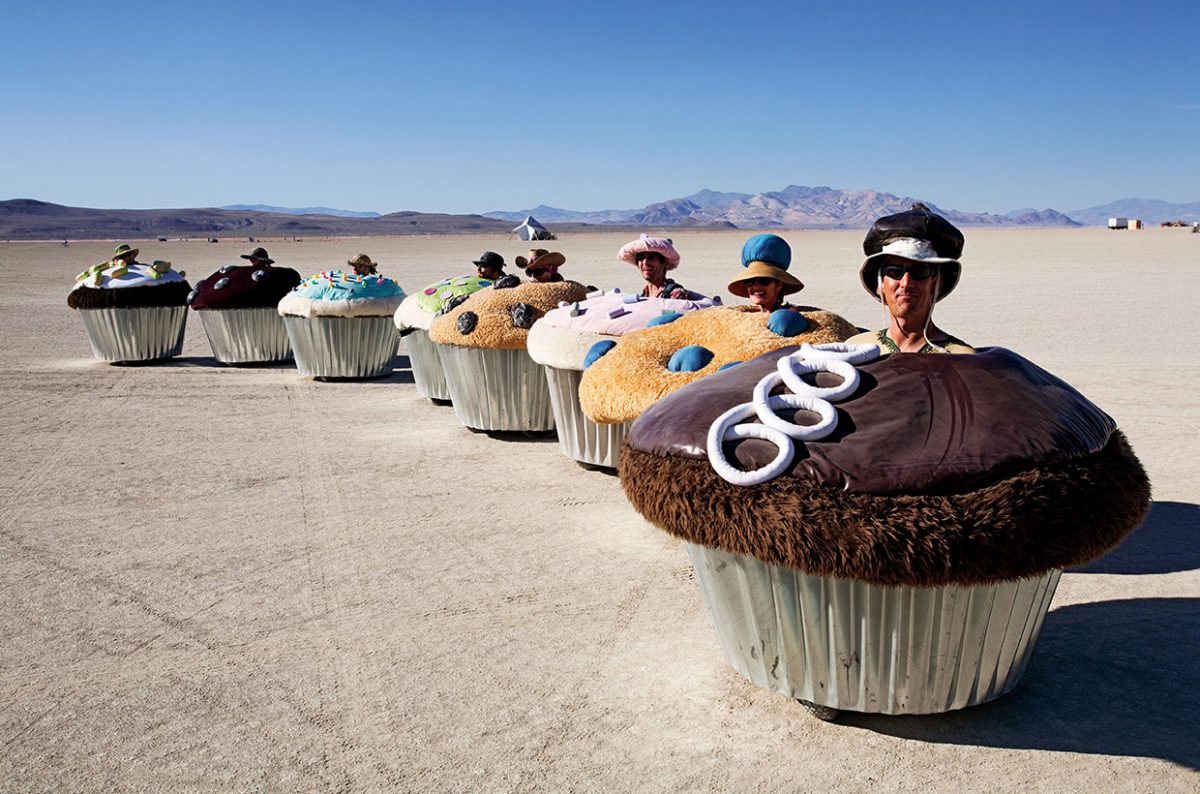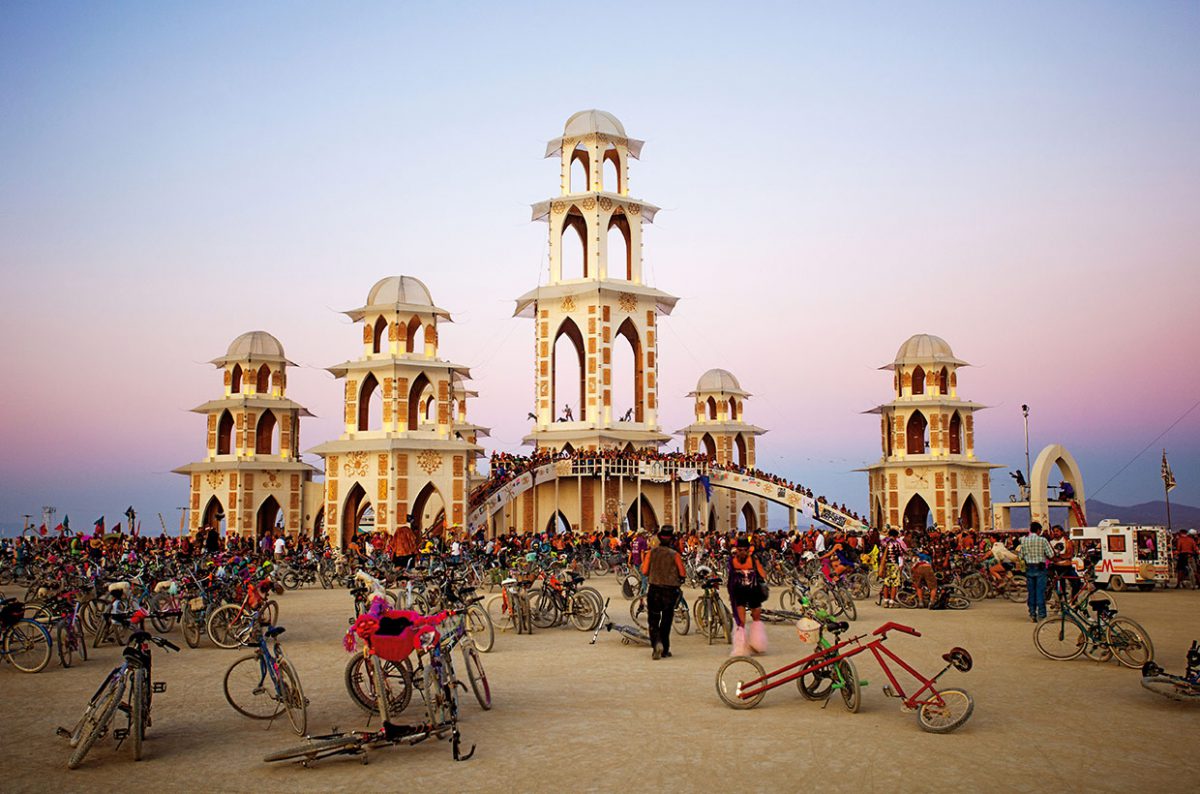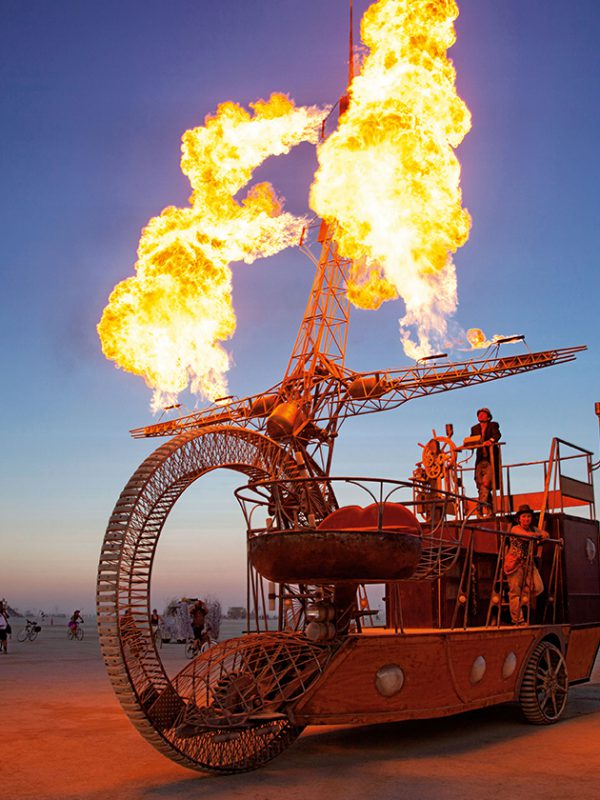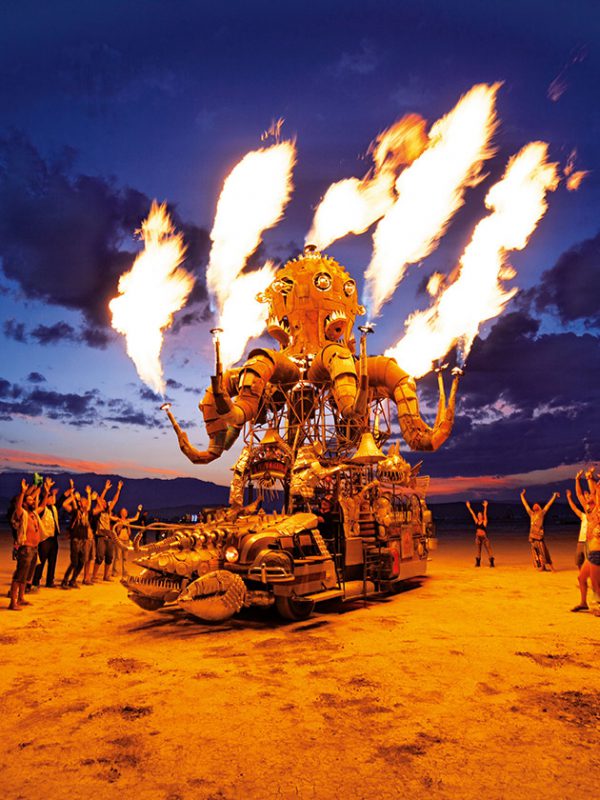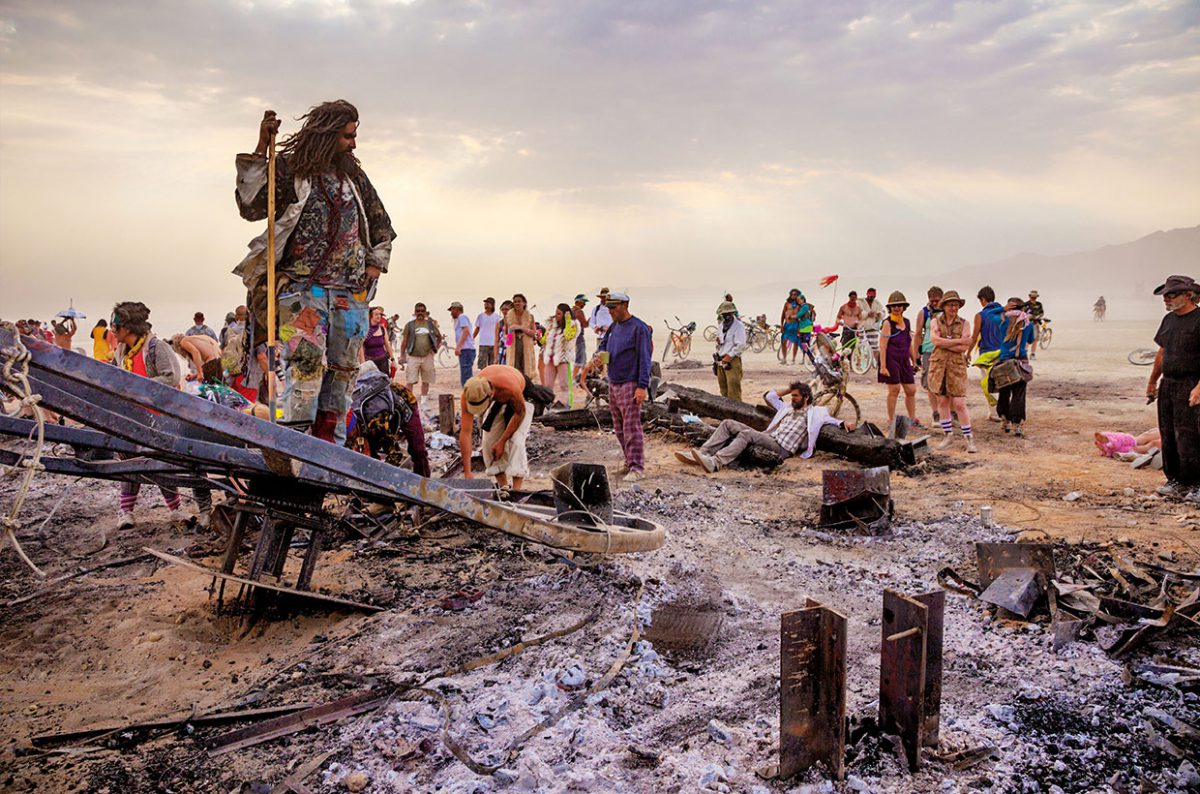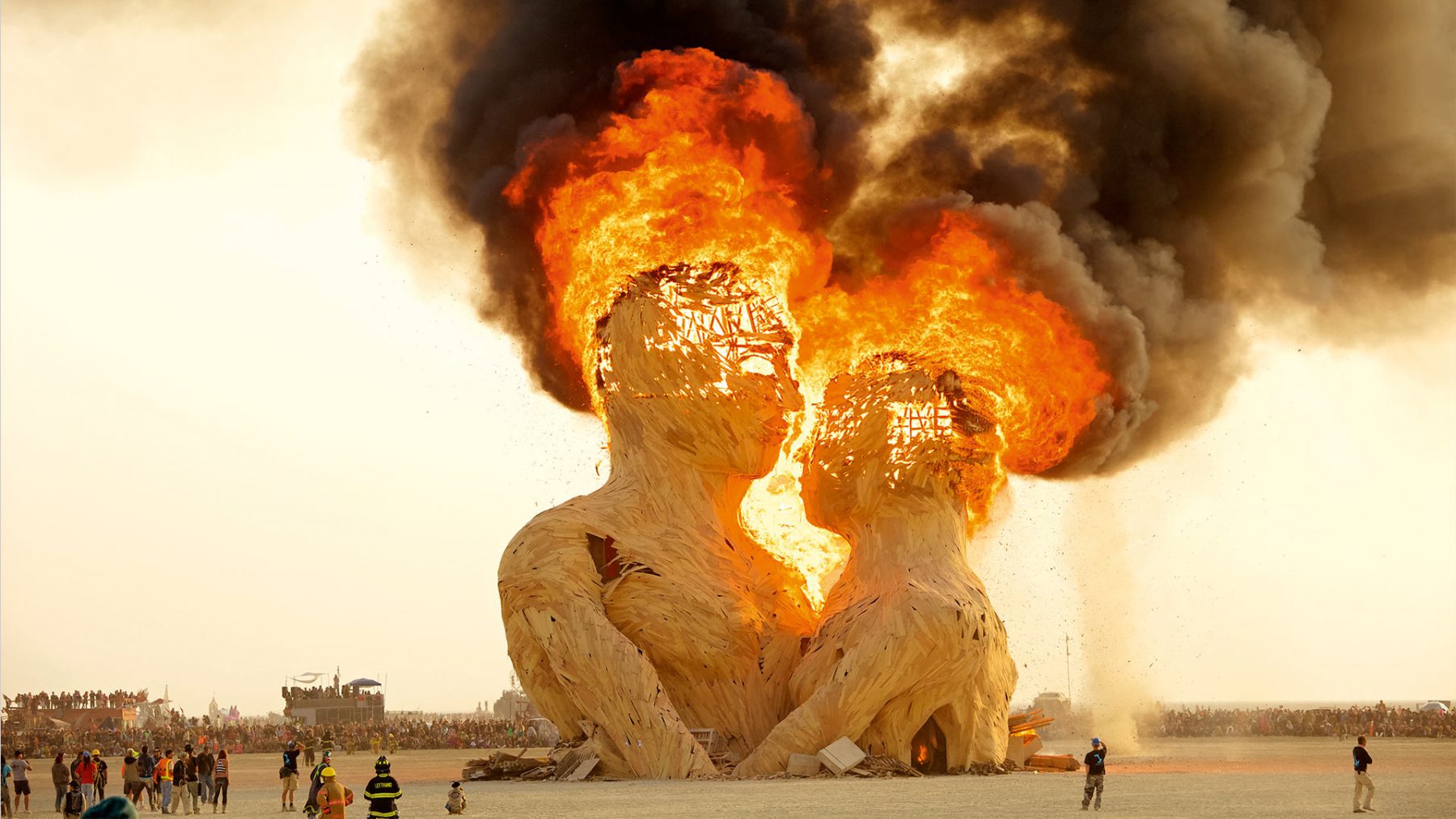Kings of the Desert by Martin Tschechne | 2nd September, 2016 | Travel
In the end, all the art goes up in flames and a cosmic calm returns. In the eight days leading up to this facinating climax, it is pandemonium in Black Rock Desert, Nevada. That is when they come together here for Burning Man – ravers, rappers, stars and screwballs, performance artists, freaks, billionaires and hippies. They all party under the scorching sun at the season’s hottest happening.
Nobody comes back from the desert without leaving something behind, and without bringing something back. Nothing afterwards is as it used to be. You have met thousands of people, danced, shared, screamed and cuddled. You have lost and found yourself – hoarse, dizzy and covered in dust. Your eyes are burning, your head is throbbing, your hearing is temporarily almost gone. Your skin – itchy and tight, your heart racing. Somewhere out there in the gleaming white expanse of desert is the shirt you ripped off when the flames shot up and the heat exploded. It is 45 degrees Celsius and more, even in the shade, of which there actually is none.
We are in Black Rock Desert, Nevada. At the height of summer in late August, there is no place farther removed from civilization than this desolate spot roughly four hours’ drive north of Reno.
The area is a salt lake of enormous proportions, dried out in prehistoric times by the scorching sun. It is surrounded by craggy mountains and stretches into the distance underneath a vast sky full of stars. This is the place where earthly pain and cosmic silence touch and merge. A place where, many years ago, a group of young men found the solitude and spiritual intensity they needed for their rituals of cleansing and new beginning. They had dragged a massive wooden statue with them, which one of the men, Larry Harvey – a lovesick Californian – wanted to feed to the fire as an effigy of a love rival. He had started performing this voodoo ritual four years previously, in 1986, at the foot of the Golden Gate Bridge, on San Francisco’s Baker Beach. But a beach is such a mundane place! It does not possess the right aura or dimensions for encounters with the eternal spirit world. Also, the police had repeatedly objected to the pyrotechnics on fire safety grounds.
When Harvey relocated his annual ritual to the desert, his heartache had presumably all but faded. Instead, more and more friends joined him. The fiery spectacle grew into a festival of magic and meditation: Burning Man – a gigantic party that gets crazier and more flamboyant every year. For eight days, trailors, tents and open campsites, which are only protected from the sun by tarpaulins, form a semi-circular, temporary city. New, ever more daring wooden constructions tower over the desert ground: huge ships on waves of sand, temples and heads you can walk into, Far Eastern palaces and gothic cathedrals, as well as abstract structures you can climb onto, swing from and marvel at. Monstrously souped-up cars cruise in-between them, as do space capsules on wheels, fire-breathing chariots and six-axle sharks. They stop, you climb aboard and go along for the ride. It’s that simple.
Last year, there were 70,000 revelers. A long line of trucks, vans and trailors created a traffic jam that stretched all the way across Nevada. In 1998, the Canadian photographer NK Guy also attended the event, attracted by the lure of this orgy of creativity and joie de vivre. He has kept going back. In 65,000 photos, Guy has documented the things that he has been bombarded with over the years. He needed time, and to repeat the experience, in order to make sense of it and grasp its profundity. This staccato assault of warmth and wit, pomp and pop, and of the lightness of being is something which can probably only be experienced at the event itself.
Not all the revelers have to travel long distances, though. After all, San Francisco has been the dream destination for hippies and flower children since the 1960s. Poets and authors like Allen Ginsberg and Ken Kesey, and the Merry Pranksters art collective had developed a lifestyle, which provoked, outraged and fascinated half the planet: sex, drugs and that incredibly relaxed West Coast sound. There was hardly a decommissioned school bus from here to Kansas City that had not been garishly painted and was not rattling around from concert to concert by the Grateful Dead and Jefferson Airplane. Hardly a music festival was complete without the clouds of marijuana smoke hovering overhead, and without “free love” being practiced in rebellion against the morality of the older generation.
Less than twenty years later, the Burning Man picked up on all of this, added new images and characters and reinterpreted the whole thing in the baking heat of the Nevada desert. So, the partying revelers, who leave behind all the troubles of their bourgeois existence, are the children or even grandchildren of the hippie generation. Nothing could have demonstrated this obvious connection better than Oscar-winner Susan Sarandon’s appearance at last year’s festival – the year in which she herself became a grandmother. It was as though the spirit of the event’s founders took her back to its very origins. She placed some of the ashes of drug guru Timothy Leary, who died in 1996, onto an artistically erected shrine, in order to surrender the whole thing to the flames once more at the end of the event. This is what happens to all the buildings, temples and structures and, finally, to the Burning Man effigy itself. That’s the tradition. Nothing must remain when the festival is over. “He would have loved it,” said the actress about her spiritual happening, and referring to Timothy Leary: “He would have considered all this an homage.”
There are no bands playing, just encounters with others, but there is dancing and there are raves, as well as impromptu music sessions – and no strict drug checks. Instead, there are crazy outfits, monsters, fairies and iced cupcakes on wheels. Ticket prices are hefty, between 390 and 1,200 dollars per person. Apart from that, everyone brings along whatever they need – provisions, costumes, music, their ego. Everyone gives freely and extends hospitality, even to strangers. Nothing is sold or marketed here. There is no mobile data or cellphone coverage. That is what the festival thrives on – enjoying the here and now with all your senses.
Some Silicon Valley tycoons (Larry Page, Mark Zuckerberg, Jeff Bezos and their entourages) have recently started arriving, too – with security guards, private chefs and air-conditioning – to compete for the title of Sun King amongst themselves. This may be very cool, but to experience the festival properly, you have to stagger back towards normality on the morning after the last fiery night. Dusty, exhausted, blessed with gifts – and happy.
